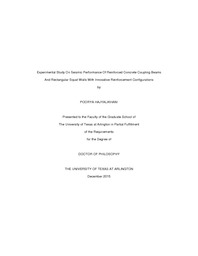
ATTENTION: The works hosted here are being migrated to a new repository that will consolidate resources, improve discoverability, and better show UTA's research impact on the global community. We will update authors as the migration progresses. Please see MavMatrix for more information.
Show simple item record
| dc.contributor.advisor | Chao, Shih-Ho | |
| dc.creator | Hajyalikhani, Poorya | |
| dc.date.accessioned | 2016-01-26T23:23:57Z | |
| dc.date.available | 2016-01-26T23:23:57Z | |
| dc.date.created | 2015-12 | |
| dc.date.issued | 2015-12-08 | |
| dc.date.submitted | December 2015 | |
| dc.identifier.uri | http://hdl.handle.net/10106/25453 | |
| dc.description.abstract | Reinforced concrete core walls, coupled by diagonally reinforced coupling beams (DCBs), are a very efficient seismic force resisting system for medium- to high-rise buildings. The diagonal reinforcing bars in DCBs are most effective when the beam has a span-to-depth ratio, ln/h, less than 2. Modern construction, due to architectural requirements, typically requires span-to-depth ratios between 2.4 to 4, which leads to a very shallow angle of inclination of the diagonal reinforcement (generally between 10 to 20 degrees). The lower angles of inclination, combined with the detailing requirements specified in ACI 318, results in reinforcement congestion as well as design and construction difficulties. These issues with DCBs can be considerably minimized by utilizing an innovative and simplistic reinforcing scheme as investigated in this study. This reinforcement scheme consists of two separate cages similar to those used for typical beams in RC special moment frames. The proposed coupling beam has high elastic stiffness and acts like a conventional coupling beam under small displacements. Upon large displacements, cracks begin developing at the mid-span and mid-height of the beams where the narrow gap is located, gradually propagating towards the beam’s ends. The cracks eventually separate the coupling beam into two slender beams where each has nearly twice the aspect ratio of the original coupling beam. This essentially transforms the shear-dominated behavior into a flexure-dominated behavior, as conventional slender beams. Because damage initiates from the center of the beam; then spreads towards the ends, the beam’s ends maintain their integrity even under very large displacements, thereby eliminating the sliding shear failure at the beam-to-wall interface. Preliminary testing results on half-scale coupling beam specimens with span-to-depth ratio of 2.4 showed that coupling beams with the proposed reinforcement scheme were able to sustain high shear stresses and large rotations before strength degradation occurred.
Subsequently, six rectangular squat wall specimens with height-to-length ratio 0.5 and 1, which were designed based the second innovative design concept using discrete confining cages to reinforce the web of the walls, were tested under lateral displacement reversals. Each wall consisted of several separate cages similar to those used for typical beams in RC special moment frames. The response of squat wall specimens showed very high shear strength and stiffness, while maintain adequate ductility due to well confinement of the wall. | |
| dc.format.mimetype | application/pdf | |
| dc.language.iso | en_US | |
| dc.subject | Coupling beams | |
| dc.subject | Squat wall | |
| dc.title | Experimental Study On Seismic Performance Of Reinforced Concrete Coupling Beams And Rectangular Squat Walls With Innovative Reinforcement Configurations | |
| dc.type | Thesis | |
| dc.contributor.committeeMember | Mehta, Madan | |
| dc.date.updated | 2016-01-26T23:26:05Z | |
| thesis.degree.department | Civil Engineering | |
| thesis.degree.grantor | The University of Texas at Arlington | |
| thesis.degree.level | Doctoral | |
| thesis.degree.name | Doctor of Philosophy in Civil Engineering | |
| dc.type.material | text | |
| dc.creator.orcid | 0000-0002-4550-1605 | |
Files in this item
- Name:
- HAJYALIKHANI-DISSERTATION-2015.pdf
- Size:
- 13.54Mb
- Format:
- PDF
This item appears in the following Collection(s)
Show simple item record


